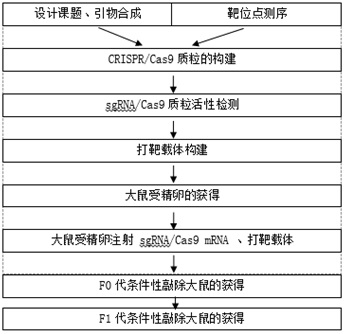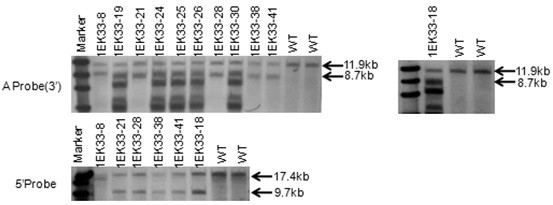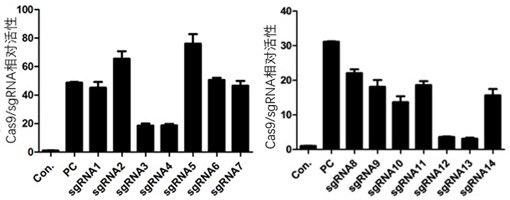Construction method and application of PHB1 gene knockout non-human animal
A technology for non-human animals and construction methods, applied in the construction and application fields of PHB1 gene knockout non-human animals, capable of solving the problems of undisclosed PHB1 gene knockout non-human animals, undisclosed choroid plexus PHB1 gene knockout non-human animals, etc.
- Summary
- Abstract
- Description
- Claims
- Application Information
AI Technical Summary
Problems solved by technology
Method used
Image
Examples
Embodiment 1
[0147] Example 1 Conditional PHB1 gene knockout Flox rats
[0148] In order to knock out the PHB1 gene, the rat PHB1 gene was mainly knocked out through the Cre / loxP recombination system, and the CRISPR / Cas9 system was used to insert LoxP into the rat PHB1 locus to obtain conditional PHB1 gene knockout Flox rats, and to conditional PHB1 gene Knock out Flox rats and introduce recombinase or recombinase expression sequences to delete the conditional PHB1 gene Knock out the PHB1 gene in Flox animals, so that the PHB1 protein in the choroid plexus tissue does not express or the expressed PHB1 protein has no function, thereby obtaining PHB1 gene knockout Rats, the specific construction method is as follows figure 1 shown.
[0149] Firstly, the CRISPR / Cas system is introduced for gene editing. The target sequence in this system determines the targeting specificity of sgRNA and the efficiency of inducing Cas9 to cut the target gene, but the gene sequence may be different in differen...
Embodiment 2
[0184] Example 2 Conditional PHB1 knockout rats
[0185] In order to obtain rats expressing Cre recombinase in the choroid plexus, specifically, the nucleotide sequence encoding iCre-ERT2 regulated by tamoxifen was knocked into the downstream of the rat Adgra3 gene promoter by using the CRISPR / Cas9 system. The expression of Cre recombinase in the mouse is regulated by the regulatory element of Adgra3 gene, so that the rat specifically expresses Cre recombinase in the choroid plexus tissue.
[0186] The Flox heterozygous rats obtained in Example 1 were crossed with the rats expressing Cre recombinase in the choroid plexus tissue to achieve tissue-specific knockout of the target gene. The specific scheme is as follows: Figure 9 shown. WT means wild-type rats, fl means F1 generation positive heterozygous rats obtained by crossing F0 generation mice with wild-type rats, and Δ means crossing fl rats with tissue-specific Cre or Cre-deleter rats Rats with tissue-specific or system...
Embodiment 3
[0196] Example 3 PHB1 whole gene knockout rat (rat with whole body knockout of PHB1)
[0197] In order to obtain the whole gene knockout rats, the fl heterozygous rats were mated with Cre-deleter rats, the mating scheme is shown in Figure 13 . WT means wild-type rats, fl means F1 generation positive heterozygous rats obtained by crossing F0 generation mice with wild-type rats, and Δ means crossing fl rats with tissue-specific Cre or Cre-deleter rats Rats with tissue-specific or systemic knockout of the gene of interest.
[0198] The first step: mating with Cre-deleter rats to obtain full gene knockout heterozygous rats; the obtained F1 generation heterozygous rats were mated with Cre-deleter rats to remove Exon4-5. The Cre-deleter rats used can be homozygous or heterozygous, such as Figure 14 shown. The genotype detection strategy is shown in Table 11:
[0199] Table 11 The first step genotype detection strategy of whole gene knockout rats
[0200]
[0201] Only het...
PUM
 Login to View More
Login to View More Abstract
Description
Claims
Application Information
 Login to View More
Login to View More - R&D
- Intellectual Property
- Life Sciences
- Materials
- Tech Scout
- Unparalleled Data Quality
- Higher Quality Content
- 60% Fewer Hallucinations
Browse by: Latest US Patents, China's latest patents, Technical Efficacy Thesaurus, Application Domain, Technology Topic, Popular Technical Reports.
© 2025 PatSnap. All rights reserved.Legal|Privacy policy|Modern Slavery Act Transparency Statement|Sitemap|About US| Contact US: help@patsnap.com



